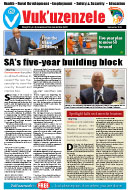Sep 2014
Sep 2014 sadminSA's five-year building block
SA's five-year building block sadminGovernment has called on all South Africans to support the new five-year plan to move the country forward and improve lives.
 Speaking at the launch of the Medium Term Strategic Framework (MTSF), Minister in the Presidency for Planning, Monitoring and Evaluation, Jeff Radebe, said the implementation of the plan cannot be done by government alone.
Speaking at the launch of the Medium Term Strategic Framework (MTSF), Minister in the Presidency for Planning, Monitoring and Evaluation, Jeff Radebe, said the implementation of the plan cannot be done by government alone.
“The implementation requires involvement of all sectors of society and an active citizenry. In addition to implementing the MTSF within government, we will pay attention to building partnerships across society to achieve the goals of the National Development Plan (NDP).
“We call on all stakeholders to work together with us in this regard,” said Minister Radebe.
The MTSF is a roadmap for the new administration to implement the NDP.
Through this document, government will build on the work that began in 1994 and ensure that there is economic transformation.
The MTSF lists the priorities that government will focus on in the next five years.
Priority Outcomes
The MTSF is structured around 14 priority outcomes, which cover the focus areas identified in the NDP.
In each of the outcomes, the framework outlines goals, indicators, targets, actions, and responsibilities.
Some of the areas that the MTSF will focus on include competitive and responsive economic infrastructure network, sustainable rural communities, sustainable human settlements, as well as accountable, effective and efficient local government.
Basic education
Government has set clear targets under this priority including achieving 100 per cent Grade R coverage, and 50 per cent of Grade 12 learners achieving 50 per cent or more in mathematics and physical science.
The plan also targets an increase in the headcount enrolments at Technical and Vocational Education and Training Colleges to 1,24 million and an increase in the percentage of university academic staff with doctorates from 38 per cent to 46 per cent.
Healthy lifestyles for all
Various targets for improving the health of the population have been set and among those targets is to raise life expectancy to at least 63 years; ensure that the generation of under-20s is largely free of HIV, and reduce the burden of disease.
Rural development and land reform
The strategy for rural areas includes improving land administration and spatial planning for integrated development, improving food security and increasing access to quality basic infrastructure and services.
For government to achieve the set targets, specific actions will be taken, among these is to develop and implement spatial development plans to guide how land is used, while prioritising the 27 resource-poor district municipalities.
Secondly, to acquire two million hectares of strategically located under-utilised land for land reform and thirdly, to bring into production one million hectares of land in communal areas and land reform projects.
Decent employment
The MTSF will focus on creating decent employment through inclusive growth; a skilled and capable workforce to support an inclusive growth path, as well as an efficient, competitive and responsive economic infrastructure network.
“These areas set out the core objectives, the major challenges that have been identified and programmes and actions to be implemented during the 2014-2019 period,” said Minister Radebe.
Spotlight falls on domestic tourism
Spotlight falls on domestic tourism sadminAs the country celebrates Tourism Month, the Minister of Tourism, Derek Hanekom, is encouraging South Africans to tour the country more often.
Delivering his departmental Budget Vote, the Minister said it was important that all South Africans toured and enjoyed the different tourist destinations across the country.
“The child of a mineworker must have the same opportunity as the child of a wealthy businessperson to visit our World Heritage Sites, to go to our national parks and botanical gardens, to attend theatre and concerts, and to visit museums and art galleries,” he explained.
Minister Hanekom added that the tourist destinations in the country belonged to all South Africans. “These sites belong to all of us and instil a shared pride that has the potential to further build our nation.
“They offer us the narrative of a common humanity in South Africa, on the continent, and in the world.”
To boost local tourism, the department will assist South Africa’s domestic marketing campaign with funds to increase the marketing campaigns.
SA Tourism’s “Sho’t Left” marketing campaign for domestic tourists is already delivering results, and will be bolstered in the next financial year by another R100 million in secured ring-fenced investment, according to the Minister.
20 years of tourism
One of the major achievements of the past 20 years is the increase in number of tourists visiting the country.
The number of accommodation establishments has almost tripled, from just 7 721 to almost 20 000, conference venues have doubled, from 1 250 to 2 598. The tourism industry directly employs 617 000 people, or 4,6 per cent of the total workforce in 2012.
The fleet of cars and coaches has more than doubled, whilst the number of airlines flying to South Africa has grown from 21 to 76.
According to Stats SA, in 2012 tourism’s direct contribution to gross domestic product (GDP) was R93 billion, with a staggering annual average real growth rate of 7,3 per cent over the past 20 years, while international tourist arrivals to the country grew to almost 10 million in 2013.
Unpacking the National Development Plan
Unpacking the National Development Plan sadminThe targets set out in the National Development Plan (NDP) will ensure that all South Africans have jobs, access to education, decent homes and quality health care by 2030.
The plan aims to ensure that all South Africans attain a decent standard of living through the elimination of poverty and reduction of inequality.
Housing, water, electricity and sanitation, safe and reliable public transport, quality education, skills development, safety and security, quality health care, social protection and employment are some of the targets that should be realised by 2030.
So far, progress has been made in some of the targets set out in the NDP in the areas of infrastructure development, job creation, education and training and improving access to health care.
Infrastructure development
South Africa’s infrastructure has seen a major boost in recent years with the upgrading of major roads with the Gauteng Freeway Improvement Project and the building of power stations in Limpopo (Medupi) and Mpumalanga (Kusile).
Dams have also received priority from government with the construction of De Hoop Dam in Mpumalanga. Rail infrastructure has not been left behind, with the Gautrain linking OR Tambo International Airport with the two major cities in Gauteng (Johannesburg and Pretoria).
The Passenger Rail Agency of South Africa is also introducing a new fleet of trains. About 3 600 trains, valued at R51 billion are expected to be delivered over a 10-year period from 2015.
Job creation
The NDP suggests the creation of 11 million jobs, increased infrastructure development, using mineral resources to benefit everyone while at the same time making sure that such resources can be used in the long-term.
Improving education and training
For South Africa to realise vision 2030, education should take a central role. A lot of work has been done in ensuring that access to education is improved and more still needs to be done.
The NDP sets out what should be done in the next years to ensure that the country achieves its goals. Among others, there should be an increase in teacher training output by expanding the bursary scheme "Funza Lushaka", which means to educate the nation, to attract learners into teaching, especially those with good passes in maths, science and languages.
Teachers should also be regularly tested in the subjects they teach to determine their level of knowledge and competence, while teacher pay should be linked to learner performance improvements.
Quality health care
At the centre of achieving all the plans of a thriving nation is a healthy nation. The NDP sets out what should be done to ensure quality health care for all South Africans. Coverage of anti-retroviral treatment to all HIV-positive people should be increased.
Community specialists should be trained in medicine, surgery including anaesthetics, obstetrics, paediatrics and psychiatry, while between 700 000 and 1,3 million community health workers should be recruited, trained and deployed to implement community-based health care.
Working together
The NDP is a plan for the whole country. Government will engage with all sectors to understand how they are contributing to implementation, and particularly to identify any obstacles to them fulfilling their role effectively.
The NDP sets out ambitious goals for poverty reduction, economic growth, economic transformation and job creation. The private sector has a major role to play in achieving these objectives.
Long-term planning and investment in the future is just as important for the private as the public sector. Government is clearly stating its commitment to the NDP, and it is important that the private sector does the same.
Where the private sector faces obstacles, sectoral dialogues will take place to identify how these obstacles can be addressed within the parameters laid out by the NDP.
Celebrating SA’s heritage and tourism sectors
Celebrating SA’s heritage and tourism sectors Estelle Greeff
September is yet another important period on our national calendar because it is Heritage Month. Coming out of the long and cold winter months, this is usually a much-awaited month of the spring rejuvenation not only of the fauna and flora, but to mankind as well. It is a time for all of us to find opportunities to be in touch with our natural landscape, explore and enjoy its beauty, harmony and tranquillity, a time for reflection and introspection about our heritage and life in general.
The 20 Years of Freedom that we are celebrating as a nation this year bear profound resonance in the heritage and tourism sector as well. In the past 20 years we have been able to reclaim our dignity as people, our culture, including languages and beliefs, history, both local and national and celebrate all people of our nation; women, men, renowned heroes, ordinary people and all formations which have an indelible footprint in our history.
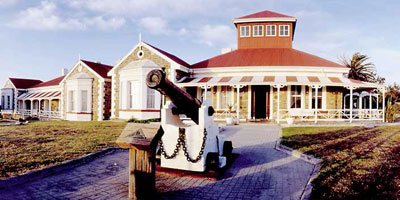 Our freedom enables all of us to traverse and explore all the corners of this beautiful land without let or hindrance of separate amenities as was the case during the previous era. Today all our artefacts, important ancestral sites and shrines have been turned from objects of scorn to sources of inspiration, awe-inspiring mirrors of our past and important guides to a brighter future. With iconic attractions such as Robben Island, Union Buildings, Apartheid Museum and Hector Peterson Memorial to name a few, we have turned the symbols of oppression to symbols of hope for a new non-racial and democratic society. All these aspirations of our new nation are captured and protected in one of our most important heritage documents, the first democratic Constitution of this nation, which is held in highest regard across many nations.
Our freedom enables all of us to traverse and explore all the corners of this beautiful land without let or hindrance of separate amenities as was the case during the previous era. Today all our artefacts, important ancestral sites and shrines have been turned from objects of scorn to sources of inspiration, awe-inspiring mirrors of our past and important guides to a brighter future. With iconic attractions such as Robben Island, Union Buildings, Apartheid Museum and Hector Peterson Memorial to name a few, we have turned the symbols of oppression to symbols of hope for a new non-racial and democratic society. All these aspirations of our new nation are captured and protected in one of our most important heritage documents, the first democratic Constitution of this nation, which is held in highest regard across many nations.
This month is therefore a period of reflection about our history, culture and heritage. It is a period which reminds us about the importance of reaching out and learning other cultures and languages, so as to enhance common understanding, cooperation, tolerance and eventually the social cohesion that we need as a nation.
September is also Tourism Month and we have to make this as meaningful as possible by making our own contributions as individuals. Certainly there is no better way to do this than by being part of the enthusiastic Sho’t Left campaign and exploring the beauty that our magnificent country offers. With its usually pleasant climate and pristine natural beauty, South African’s heritage and tourism sector is unique, which is why it continues to be a compelling source of attraction for tourists from all the corners of the world.
During the State of the Nation address, I said: “Despite tough global trading conditions in its traditional markets, South Africa’s tourism sector continued to show positive growth in 2013, reaching a record high of 9,6 million international tourist arrivals.
“People love our country and continue to visit South Africa. We have set a target to increase the number of foreign visitor arrivals to more than 15 million annually by 2017. We are also looking at increasing the contribution of tourism to the country’s revenue to more than R125 billion by 2017.”
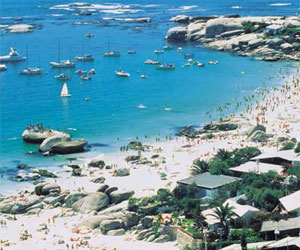 Also of significance is the industry’s resilience during the global economic downturn. Building from the legacy of 2010 FIFA World Cup, we must continue to unlock the economic potential of our heritage and tourism sectors. As indicated, the success of our tourism strategy starts with us. A tourist does not always have to be from outside our country; we can all be sightseers starting from our localities. We should lead throngs of tourists who flock into our country by exploring our own country as well. Tourism is an important sector in our economy and has the unique potential to showcase our culture, hospitality and investment opportunities in our country. Together with the green economy, it is one of the six job drivers identified in our New Growth Path. Other job drivers are infrastructure development, agriculture, mining and beneficiation, and manufacturing. Government has singled out these for a special focus as part of the campaign against poverty, inequality and unemployment. It is for this reason that our government is investing in growing this sector, which carries enormous potential for both urban and rural areas alike.
Also of significance is the industry’s resilience during the global economic downturn. Building from the legacy of 2010 FIFA World Cup, we must continue to unlock the economic potential of our heritage and tourism sectors. As indicated, the success of our tourism strategy starts with us. A tourist does not always have to be from outside our country; we can all be sightseers starting from our localities. We should lead throngs of tourists who flock into our country by exploring our own country as well. Tourism is an important sector in our economy and has the unique potential to showcase our culture, hospitality and investment opportunities in our country. Together with the green economy, it is one of the six job drivers identified in our New Growth Path. Other job drivers are infrastructure development, agriculture, mining and beneficiation, and manufacturing. Government has singled out these for a special focus as part of the campaign against poverty, inequality and unemployment. It is for this reason that our government is investing in growing this sector, which carries enormous potential for both urban and rural areas alike.
Part of government’s strategy is to support small businesses in the tourism sector, including with the marketing of their products. Cultural heritage tourism provides rare opportunities for a wide range of SMMEs in the arts and craft industries, heritage sites and cultural festivals. This sector is pivotal in transforming the economic ownership patterns in this country to include the previously marginalised people. Tourist arrivals to South Africa in 2013 showed steady growth and we are expecting that this year the industry will increase on the 9,5 per cent contribution that the industry made to the GDP. With global uncertainties such as the recent outbreak of the deadly Ebola virus in some parts of West Africa, government reassures the nation of its alertness at all ports of entry for surveillance for viral hemorrhagic fevers.
Clearly our tourism strategy is proving to be successful and this must be commended. We also acknowledge the contribution of all South Africans, as we all play a role, through our hospitality and Ubuntu, in making tourists feel welcome in our beautiful country. All South Africans, especially those who travel overseas regularly must take the opportunity to market South Africa, radiate and extol the virtues of our peaceful land. All South Africans are ambassadors of brand South Africa. It is important that we always remember that and promote our country at every available opportunity so that we boost our tourism sector and promote the creation of much-needed jobs in our country, especially among the youth.
Finally, let us welcome our guests and enjoy the excitement of this month!
Jacob G Zuma
President of the Republic of South Africa
Govt aims to curb unplanned pregnancies
Govt aims to curb unplanned pregnancies sadminThe Department of Health has called on South African women, especially teenage girls, to use contraceptives to prevent unplanned pregnancies.
According to the department, in the past year there were 89 000 abortions at public health facilities, while 3 200 women died during pregnancy or up to six weeks after delivery or the termination of a pregnancy.
 “Eight per cent of the total recorded pregnancies in the country are of teenage mothers under 18 years. These young mothers account for more than a third of maternal deaths. The number of illegal abortions that often leave women either infertile or dead is a great concern and unfortunately goes unrecorded,” the department said.
“Eight per cent of the total recorded pregnancies in the country are of teenage mothers under 18 years. These young mothers account for more than a third of maternal deaths. The number of illegal abortions that often leave women either infertile or dead is a great concern and unfortunately goes unrecorded,” the department said.
A number of contraceptive methods, which can prevent unwanted pregnancies and as a result maternal deaths, are available at the country’s public health facilities.
The department encouraged women to use one of these methods - the newly introduced sub-dermal implants - together with condoms for protection against HIV and sexually transmitted infections (STIs).
The device is implanted just under the skin on the inner upper arm, has fewer side effects compared to other methods of contraception and prevents unintended pregnancy for three years.
Other methods, which should be used together with the female or male condoms, include contraceptive pills, injectable contraceptive, intra uterine devices, voluntary sterilisation and also emergency contraception for incidents of unprotected consensual or non-consensual sex.
 The department also announced that it would be rolling out two million flavoured condoms to higher education institutions.
The department also announced that it would be rolling out two million flavoured condoms to higher education institutions.
Minister of Health Aaron Motsoaledi said he had spoken to many young people on the issue of HIV and the youth had told him that using the government-issued Choice condoms were “not cool”.
“We are excited about these young people at universities and Further Education and Training colleges. We know there are two million of them and we are saying let's give them coloured and flavoured condoms. We are trying to test what might work; maybe these condoms will be cooler to young people than the Choice condom.”
The condoms will be available in strawberry (red), banana (yellow) and grape (purple) flavours.
Minister Motsoaledi said he hoped the flavoured condoms would become popular with young people.
According to the department, factors that contribute to unplanned pregnancies in teenagers and women include a lack of awareness and knowledge of contraceptives and fertility planning, cultural expectations of fertility and childbearing, peer pressure and women’s status in their relationships and society.
The department is working hard to give more women access to contraception and information on the use of contraception and a condom as dual protection to avoid unintended pregnancies, HIV and other STIs.
During his recent Budget Vote, Minister Motsoaledi said family planning was an important element in reducing maternal mortality.
“We know from the National Committee on Confidential Enquiry on Maternal Death triennial studies that of the one million women who fall pregnant annually, eight per cent are girls under the age of 18 years but they account for a whopping 36 per cent of maternal deaths.”
“The United Nations Fund for Population Development (UNFP) has backed our argument, that one of the main drivers of teenage pregnancy in Sub-Saharan Africa is lack of family planning.
“In dealing with this scourge, we launched a new National Family Planning Campaign under the theme ‘Dual Protection’ including consistent use of a condom together with another form of contraception device,” the Minister explained.
Maternal deaths on the decline
Maternal deaths on the decline sadminAngeline Mtsweni, 29, is nine months pregnant and expecting her second baby boy.
She says being pregnant is a wonderful feeling but the most important thing is to ensure that she and her new bundle of joy are healthy.
 Mtsweni lives in Mamelodi and has been visiting the Stanza Bopape Clinic in Mamelodi, Gauteng, for antenatal visits from 14 weeks of pregnancy.
Mtsweni lives in Mamelodi and has been visiting the Stanza Bopape Clinic in Mamelodi, Gauteng, for antenatal visits from 14 weeks of pregnancy.
“I am very excited to be a mom again. More importantly I want to ensure that I am healthy for motherhood and my little boy is also healthy. This is why I come to my antenatal appointments,” she said.
According to the Department of Health early and quality ante- and postnatal services are an essential for mother and child’s health as it helps reduce maternal and child mortality rates.
The University of Cape Town’s Hatter Institute for Cardiovascular Research in Africa, together with the Institute for Health Metrics and Evaluation (IHME) at the University of Washington, did a study on maternal deaths.
According to the findings the number of maternal deaths has dropped from about 376 000 in 1990 to about 293 000 in 2013.
Maternal mortality in the country has dropped by almost seven per cent a year over the past decade – at 171.4 maternal deaths per 100 000 live births.
At the clinic, nurses check Mtsweni’s blood pressure and the position of the baby. She also gets health education from the clinic’s qualified nutritionist on her diet and living a healthy lifestyle.
“If there is a problem with the baby the nurses refer us to a regional hospital to be further examined by a specialist.”
Mtsweni says she is aware that attending antenatal appointments helps prevent maternal deaths.
“I always encourage other young pregnant mothers to go to their visits because the nurses give the best possible advice when examining us.”
Noria Matlala, who is a midwife at the clinic, says the antenatal care programme has received a good response from the community.
“We have very few women delivering their babies without undergoing the programme. In one day we get between 50 and 60 pregnant women attending the programme.”
When pregnant women visit the clinic nurses confirm the pregnancy if it is their first visit, monitor the blood pressure and weight of the mother-to-be and give the estimated date of delivery.
“We encourage them to come for follow up visits. We also give them supplements, educate them on what to eat and the importance of exercise. They visit the clinic every six weeks and if the need arises we refer the women to the hospital.”
Matlala says the antenatal programme is a big help for the community.
“There are few unplanned deliveries and fewer women dying because of complications during labour."
In 2000, global leaders committed themselves to meeting eight Millennium Development Goals (MDGs) by 2015.
The MDGs include halving extreme poverty rates, curbing the spread of HIV and AIDS and providing universal primary education, all by the target date of 2015.
Reducing child mortality and improving maternal mortality falls under MDG 5 and remains an area of focus for the Department of Health.
MDG 5 also calls for a 75 per cent reduction in maternal deaths by 2015.
During his recent Budget Vote, Health Minister Aaron Motsoaledi said the international health fraternity agreed that there should be a second world health agenda beyond 2015.
Minister Motsoaledi said this agenda had to pursue three goals:
- MDGs related to child mortality, maternal mortality and the fight against HIV and AIDS, TB and Malaria should continue far beyond 2015.
- The world must decisively deal with the risk factors that cause non-communicable diseases, which are fuelled by factors such as smoking, harmful use of alcohol, poor diet and lack of exercise.
- Every country should introduce universal health coverage. For its part, South Africa is currently piloting the National Health Insurance.
Matric pass requirements under review
Matric pass requirements under review sadminA massive revamp to the National Senior Certificate (NSC) examinations is on the cards following a ministerial task team report on the quality of the matric pass requirements.
The 188-page report, which investigates the pass requirements for the matric certificate, highlighted the improved progress of the exams over the years, yet also made recommendations to address its serious shortfalls.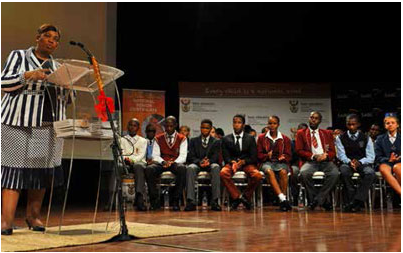
The report was recently handed over to Basic Education Minister Angie Motshekga who had set up the task team earlier this year to sift out challenges and complaints over the pass requirements. The report is currently being reviewed by the Minister and provincial education heads.
The report’s major recommendations include making mathematics compulsory at all schools, raising the average pass grade from the current 33 per cent to a newly proposed 40 per cent, removing life orientation as a prerequisite subject, introducing an exit certificate for Grade 9 learners, investigating the standard of African languages as a first and home language, and improving the selection criteria of exam markers.
One of the reasons for increasing the average pass grade is to improve learners’ chances of being better prepared to pursue tertiary studies or find suitable employment once they complete their schooling.
The report highlighted that if maths was made compulsory, it would have to be phased in over a few years to avoid a decline in overall enrolments in science-related subjects. One of the key solutions mentioned in the report was that well-trained, fully professional teachers were ultimately the key to the development of the education system.
To further boost mathematics and science as an integral part of the curriculum, the department has also rolled out teacher training workshops to further teachers' skills and competencies.
The report also made mention that learners who did not meet the pass grade for their sixth subject would still be allowed to pass their matric exams. This would be done on the condition that all exam requirements have been met and that there is evidence of the School-based Assessment that the subject has been completed by the learner.
The South African Council for Educators chief executive officer Rej Brijraj has applauded the ministerial task team for the great work on the report.
Brijraj welcomed the recommendation regarding the removal of life orientation as a subject from the pass requirements, yet added that it should remain in other grades to help learners develop and understand the important values and lessons it teaches.
Regarding mathematics being made a compulsory subject, Brijraj added, “We need to focus on the content knowledge of our teachers. Research over the last 10 years has shown that most mathematics teachers, for example do not have the content knowledge needed to impart to their students even a basic understanding of the subject."
Brijraj also welcomed the improvement on the pass requirements for entry to higher certificate study. “Our learners should be persuaded to work much harder,” he said. He added that the new proposed pass rate will also assist in reducing the number of dropouts at tertiary institutions.
Taxila Secondary School pupils take to water in Sweden
Taxila Secondary School pupils take to water in Sweden sadminWhen the group of three pupils from Taxila Secondary in Limpopo entered the South African Youth in Water Competition they only had one goal in mind: to take home the prize.
“During the award ceremony when the winner was announced we knew that we had won because it was our goal to be number one,” explains Dipuo Nthane, 17, a Grade 11 pupil who is part of the team. The pupils built a model house with a purification system, which won them the national competition. Their prize is an all-expenses paid trip to Sweden to compete in the Stockholm Junior Water International.
They also won a cash prize of R8 000 to be shared among themselves and a full bursary to further their studies in a water-related field at any South African tertiary institution.
The team is made up of two girls and one boy namely Nthane, Nthabiseng Motona, 17, also in Grade 11 and Tebogo Mamabolo, 16, in Grade 10.
They came up with an idea of purifying rainwater from the roof to drinkable water using nanotechnology.
Nanotechnology deals with measurements and tolerances of less than 100 nanometres, especially the use of individual atoms and molecules.
“The problem with this system is that it is not safe and the water cannot be used for drinking. Our main aim was that the water that is harvested from the roof is safe enough to drink.”
“We used nanotechnology to purify water for example silver has been known to kill bacteria, we took science to a smaller scale,” said Motona.
The 2014 Stockholm Junior Water Prize International Final takes place during the World Water Week in Stockholm, Sweden from 31 August – 5 September 2014.
The group is very excited about attending the competition and representing the country.
Mamabolo says they got the idea for a water purification model during a debating competition.
“We decided to take what was being debated and make it practical and we built our own model house,” adds Motona.
Nthane said the project was also inspired by the lack of water in her community.
“I come from Blood River a semi-rural area. We have a problem of water being scarce. This project also showed me the importance of water conservation and technology.”
Mamabolo says while busy with the project they had the rural areas in mind because of inconsistent supply of water. The group is adamant that they have a future in the field of science and technology.
Nthane and Motona want to study engineering while Mamabolo wants to do microbiology.
School principal Caiphus Ramara said he was very proud of the learners' achievement and was confident that they would win the international competition.
Taxila Secondary School, located in Polokwane, had a 96,5 percent pass rate for the Grade 12 class of 2013.
According to the Department of Water and Sanitation more than 94 per cent of people have access to water and 84 per cent have access to sanitation systems.
Thuthuka produces high quality results
Thuthuka produces high quality results sadminThe South African Institute of Charted Accountants (SAICA) is working with provincial education departments to increase mathematics pass rates in the country.
 SAICA, through its Thuthuka Education Upliftment Fund (TEUF), runs the SAICA Thuthuka Fund Math Camp for about 200 learners per province.
SAICA, through its Thuthuka Education Upliftment Fund (TEUF), runs the SAICA Thuthuka Fund Math Camp for about 200 learners per province.
TEUF was launched in 2002 in the Eastern Cape and has grown from one provincially based project to more than 16 projects. Financial support for the project comes from SAICA, provincial departments of education and the South African Reverse Bank.
The selection criteria for learner participants is based on a minimum 60 per cent pass mark in mathematics, science and accounting. The objectives of the camp include assisting learners to acquire and improve the skills needed to achieve a post-matric career.
“The camps consist of five to seven day workshops where learners are motivated to develop key skills in numeracy, literacy, study skills examination techniques and other soft skills,’’ said Gugu Makhanya, Project Director: Transformation and Growth at SAICA.
At the camps, learners are not only provided with skills but are assisted with examination preparation.
“We have noticed a steady and sustained improvement in MST National Senior Certificate examination results. The results indicate that we have reached parity with the participation rate of girls versus boys in mathematics and physical science. We still need to improve on the quality of the passes in mathematics and science especially for our girl learners – in order to bring them into parity with the quality of passes of boys,” said Mathanzima Mweli, the Acting Deputy Director-General for Curriculum Policy Support at the Department of Basic Education.
Since its inception, the mathematics development school camps have produced more than 100 students who studied towards a B.Com Accounting degree.
Ntaoleng Patricia Khoabane, a Grade 12 learner at the General Smuts High School in Vereeniging, says the Thuthuka Math Camps have helped her.
“I have gained more skills and I am able to assess and solve problems without a glitch,” said Khoabane.
South Africa's eight wonders
South Africa's eight wonders sadminSouth Africa is not only home to some of world’s best scenic views, coastlines and wildlife but it also boasts eight world heritage sites as determined by the United Nations Educational, Scientific and Cultural Organisation's World Heritage Committee.
A heritage site is a place of cultural or natural significance that is recognised as being of outstanding international importance and deserving of special protection. South Africa’s eight heritage sites consist of four cultural, three natural and one mixed site. Here is more information on South Africa’s heritage sites:
iSimangaliso Wetland Park
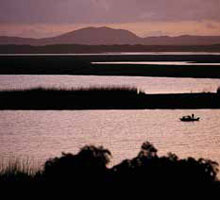 iSimangaliso Wetland Park is South Africa’s first world heritage site and is situated in KwaZulu-Natal’s central coast of Zululand. Previously known as Greater St Lucia Wetland Park, iSimangaliso Wetland Park is home to a range of species of plant and animal life. With its exceptional beauty, the park contains lake systems, interlinking ecosystems, most of South Africa’s remaining swamp forests, Africa’s largest estuarine system and coastal dunes.
iSimangaliso Wetland Park is South Africa’s first world heritage site and is situated in KwaZulu-Natal’s central coast of Zululand. Previously known as Greater St Lucia Wetland Park, iSimangaliso Wetland Park is home to a range of species of plant and animal life. With its exceptional beauty, the park contains lake systems, interlinking ecosystems, most of South Africa’s remaining swamp forests, Africa’s largest estuarine system and coastal dunes.
Robben Island
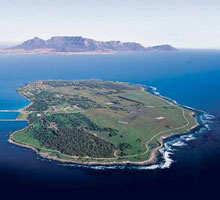 Robben Island has become a symbol of “the triumph of democracy and freedom over oppression”. The island is situated offshore from Cape Town and is also home to the Robben Island Museum. In 1999 the World Heritage Committee declared Robben Island a World Heritage site of cultural significance.
Robben Island has become a symbol of “the triumph of democracy and freedom over oppression”. The island is situated offshore from Cape Town and is also home to the Robben Island Museum. In 1999 the World Heritage Committee declared Robben Island a World Heritage site of cultural significance.
Cradle of Humankind
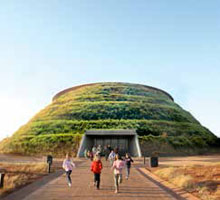 The Cradle of HumanKind is in Sterkfontein, Swartkrans, Kromdraai and surrounding areas. These regions have some of the world’s richest early human fossils or remains thereof. These fossils are as old as 3,5 million years old and together with the remains of ancient plants and animals, stretch over a distance of 47 000 hectares. The area provides important information on early humans who appeared 5 million years ago. Excavations in the area produced a number of complete skeletons and major finds.
The Cradle of HumanKind is in Sterkfontein, Swartkrans, Kromdraai and surrounding areas. These regions have some of the world’s richest early human fossils or remains thereof. These fossils are as old as 3,5 million years old and together with the remains of ancient plants and animals, stretch over a distance of 47 000 hectares. The area provides important information on early humans who appeared 5 million years ago. Excavations in the area produced a number of complete skeletons and major finds.
Maloti Drakensberg Park
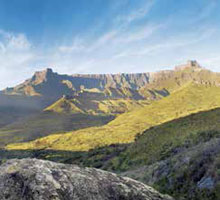 The Maloti Drakensberg Park is a mixture of both cultural and natural significance. Culturally because of its rock paintings, and naturally because of its location in the Drakensberg mountains. The park is situated west of KZN on the Lesotho border. For more than 4 000 years, the mountains have been home to South Africa’s indigenous people, the Khoisan. This would explain the rock paintings, the largest collection in Africa. These rock paintings are educational and shed light on how the San people viewed the world they lived in.
The Maloti Drakensberg Park is a mixture of both cultural and natural significance. Culturally because of its rock paintings, and naturally because of its location in the Drakensberg mountains. The park is situated west of KZN on the Lesotho border. For more than 4 000 years, the mountains have been home to South Africa’s indigenous people, the Khoisan. This would explain the rock paintings, the largest collection in Africa. These rock paintings are educational and shed light on how the San people viewed the world they lived in.
Mapungubwe Cultural Landscape
 Mapungubwe means “place of the stone of wisdom”. It was known as South Africa’s First Kingdom where people of affluent status traded with Egypt, India and China. Mapungubwe is situated in the grasslands of the Mapungubwe National Park, which is at the joining of the Limpopo and Shashe Rivers in Limpopo. It borders South Africa, Zimbabwe and Botswana, which would explain the reasons for it being a trading centre.
Mapungubwe means “place of the stone of wisdom”. It was known as South Africa’s First Kingdom where people of affluent status traded with Egypt, India and China. Mapungubwe is situated in the grasslands of the Mapungubwe National Park, which is at the joining of the Limpopo and Shashe Rivers in Limpopo. It borders South Africa, Zimbabwe and Botswana, which would explain the reasons for it being a trading centre.
Cape Floral Region
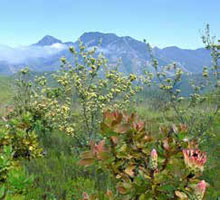 The Cape Floral Region contains 3 per cent of the world’s plant species. It consists of eight protected areas, surrounded by land and sea, stretching from the Cape Peninsula to the Eastern Cape. Kirstenbosch Botanical Garden, which is part of the region, became the first Botanical Gardens to be part of a world heritage site. The Cape Floral Region has a large number of diverse plant and animal species, ranking South Africa as third highest in biodiversity. This region is also home to many indigenous plants not known to any other place on earth. Although small in landmass, the region is home to 20 per cent of Africa’s plant life.
The Cape Floral Region contains 3 per cent of the world’s plant species. It consists of eight protected areas, surrounded by land and sea, stretching from the Cape Peninsula to the Eastern Cape. Kirstenbosch Botanical Garden, which is part of the region, became the first Botanical Gardens to be part of a world heritage site. The Cape Floral Region has a large number of diverse plant and animal species, ranking South Africa as third highest in biodiversity. This region is also home to many indigenous plants not known to any other place on earth. Although small in landmass, the region is home to 20 per cent of Africa’s plant life.
Richtersveld Cultural Landscape
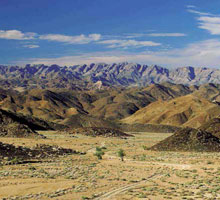 This landscape covers 160 000 hectares of rocky desert. A unique feature about this site is that it is owned and managed by a community, known as the Nama people. Although the temperatures in this area are very high, it provides a semi-nomadic pastoral livelihood for the Nama people. The Nama people are descendants of the Khoisan people. Due to the land restitution programme, the Nama people were given back their land a few years ago. Today the Nama people live in the land and conserve its natural surroundings. The Nama people are still nomadic to this day.
This landscape covers 160 000 hectares of rocky desert. A unique feature about this site is that it is owned and managed by a community, known as the Nama people. Although the temperatures in this area are very high, it provides a semi-nomadic pastoral livelihood for the Nama people. The Nama people are descendants of the Khoisan people. Due to the land restitution programme, the Nama people were given back their land a few years ago. Today the Nama people live in the land and conserve its natural surroundings. The Nama people are still nomadic to this day.
Vredefort Dome
 Near the town of Vredefort in the Free State, some 2 billion years ago, a meteorite hit the earth and created an enormous impact crater, today known as the Vredefort Dome. Although in the top three for crater structures, the Vredefot dome is the oldest and largest meteorite visible on the planet. The original crater must have been about 250- 300 kilometres in diameter, but has eroded away over the years. The original impact of the meteorite was 380 kilometres across, which consists of three circles of uplifted rock. The inner circle was named a world heritage site and is visible over the range of hills near Parys and Vredefort.
Near the town of Vredefort in the Free State, some 2 billion years ago, a meteorite hit the earth and created an enormous impact crater, today known as the Vredefort Dome. Although in the top three for crater structures, the Vredefot dome is the oldest and largest meteorite visible on the planet. The original crater must have been about 250- 300 kilometres in diameter, but has eroded away over the years. The original impact of the meteorite was 380 kilometres across, which consists of three circles of uplifted rock. The inner circle was named a world heritage site and is visible over the range of hills near Parys and Vredefort.
*Information obtained from the Department of Arts and Culture and www.southafrica.info. Pictures obtained from www.southafrica.info
Together we move South Africa forward
Together we move South Africa forward sadminProgramme of Action
“South Africa is a much better place to live in than it was in 1994 and the lives of millions of our people have improved.”
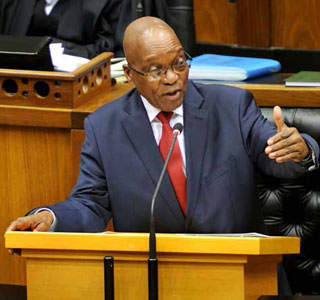 “However, as the National Development Plan and the Presidency’s Twenty Year Review highlight, the triple challenges of poverty, inequality and unemployment continue to affect the lives of many people.
“However, as the National Development Plan and the Presidency’s Twenty Year Review highlight, the triple challenges of poverty, inequality and unemployment continue to affect the lives of many people.
“As we enter the second phase of our transition from apartheid to a national democratic society, we have to embark on radical socioeconomic transformation to push back the triple challenges.
“Change will not come about without some far-reaching interventions,” said President Jacob Zuma in his State of the Nation Address in June.
The recently launched Medium-Term Strategic Framework (MTSF) outlines government's plans for the next five years. Government has set itself targets that it would like to achieve over the next five years based on the commitments made in the election manifesto.
Vuk'uzenzele unpacks government’s Programme of Action based on the MTSF targets over the next five years.
Economic development and employment
Government’s programme of radical economic transformation aims to ensure more rapid, sustainable growth, higher investment, increased employment, reduced inequality and the deracialisation of the economy.
Over the next five years, government’s key targets include:
- An increase in the gross domestic product (GDP) growth rate from 2,5 per cent in 2012 to 5 percent in 2019.
- An increase in the rate of investment to 25 percent of GDP in 2019.
- The share in household income of the poorest 60 per cent of households rising from 5,6 per cent in 2011/12 to 10 per cent in 2019.
- A decrease in the official unemployment rate from 25 per cent in the first quarter of 2013 to 14 per cent in 2020.
Building a better SA
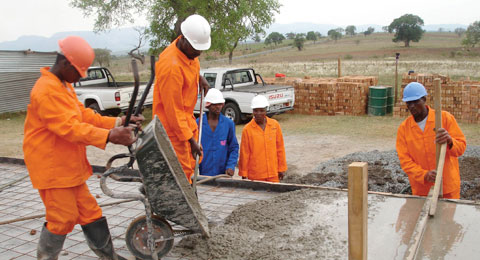 Government will, through the work of the Presidential Infrastructure Coordinating Commission, ensure sufficient energy supply for economic growth and address other infrastructural constraints to growth.
Government will, through the work of the Presidential Infrastructure Coordinating Commission, ensure sufficient energy supply for economic growth and address other infrastructural constraints to growth.
A key priority is to expand electricity supply. Power from the new Medupi coal-fired plant will ease the electricity supply constraint in 2015, and long-term energy security will continue to be a strategic focus.
Government will look at a mix of energy options including coal, nuclear, shale gas, offshore oil and gas and renewables, taking into account environmental, financial, social and other considerations.
The Renewable Energy Independent Power Producers (IPP) programme will continue and the potential for base-load IPP projects will be explored. Expediting the exploration of alternative energy sources in shale and offshore gas will be a priority, both for energy supply and as a potential major source of economic growth.
“Government will continue with various other infrastructure projects that will change the living conditions of our people and boost economic growth,” President Zuma said.
Youth & women employment
- Government will encourage business to target youth and women for employment, and business opportunities, and to use the employment incentive scheme.
- The Youth Employment Accord, which was signed in Soweto, near Johannesburg, on 18 April 2013 by government, organised labour, organised business as well as community and youth formations, offers mass-based, collective and realistic approach to accelerate job creation for young South Africans.
Investing in transport
- Public investments in the transport sector will open up broader growth opportunities, both through improved urban commuter services and a significant expansion in Transnet’s capacity to carry freight by rail.
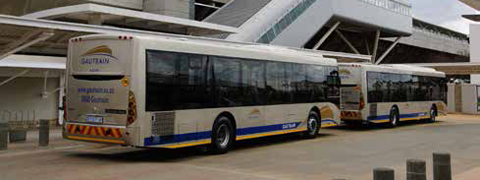
Creating jobs
Government will use the Expanded Public Works Programme (EPWP), in particular the Community Work Programme (CWP), to provide additional employment opportunities, training and work experience, and increase social cohesion.
The EPWP will provide six million work opportunities by 2019 and the CWP will be expanded to have at least one site in every municipality by the end of 2014.
Expanding the information & communications infrastructure
- An additional priority is to expand, modernise and increase the affordability and accessibility of information and communications infrastructure and electronic communication services, including broadband and digital broadcasting. The work of all the state-owned information technology agencies will be aligned towards these objectives.

To ensure an efficient, competitive and responsive economic infrastructure network, government aims to achieve the following over the next five years:
- Increasing the electricity generation reserve margin from 1 per cent currently to 19 per cent in 2019.
- A 5 per cent increase in bulk water resources commissioned in comparison to 2014.
- An increase in broadband penetration from 33,7 per cent in 2013 to 80 per cent in 2019.
- Making sea ports and inland terminals work better from 28 to 35 average crane moves per hour by 2019.
Improving the quality of and expanding access to education & training
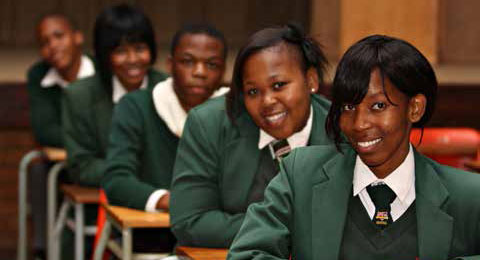 Education plays an important role in equalising individuals’ life chances, promoting economic mobility, advancing economic growth, creating employment, eradicating poverty and reducing inequality.
Education plays an important role in equalising individuals’ life chances, promoting economic mobility, advancing economic growth, creating employment, eradicating poverty and reducing inequality.
Over the next five years, government aims to achieve the following:
- All children between ages 7 and 18 should be in school.
- 65 per cent of learners should be in class groups appropriate to their age.
- 60 per cent of each age cohort should receive either a National Senior Certificate or an alternative vocational or further education and training qualification.
- 75 per cent of learners tested through the Annual National Assessments in Grades 3, 6 and 9 should achieve above 50 per cent in both literacy and numeracy.
- The number of Grade 12 level learners qualifying for university entrance will be increased to 250 000 (172 000 in 2013).
- The number of students enrolled at universities will increase from 950 000 in 2013 to 1,07 million.
- 90 per cent of learners who require workplace-based training and experience to complete their qualification and be placed.
- The number of students enrolled in Technical and Vocational Education and Training (TVET) colleges will increase from 670 455 in 2013 to 1,238 million.
- University enrolment in foundation programmes will increase to 36 000 students from 16 300 in 2013.
- The number of artisans produced every year will increase to 24 000 per year by 2019 (from 18 110 in 2013), to meet the needs of a growing economy.
- To support the knowledge economy, the number of PhD graduates will increase to 3 000 per year by 2019 (from 1 870 per year in 2013).
- The number of graduates in engineering science will increase to 57 000 over the five year period – 9 974 were produced in 2012.
- The number of graduates in human and animal health will increase to 45 000 over the five year period – 8 015 were produced in 2012.
- The number of graduates in natural and physical sciences will increase to 36 000 over the five year period – 6 366 were produced in 2012.
- To support basic education, universities will produce 20 000 teacher graduates per year by 2019, an increase from 13 740 in 2013.
- To support the quality of lecturing, 10 universities will offer TVET lecturing qualifications by 2019.
- 30 per cent of TVET college lecturers should have workplace exposure every year by 2019.
- The Teaching and Research Development Grant will increase from 50 academics in 2012 to 400 academics by 2019.
- To transform the historical and social composition of the academic work force, the number of new black entrants will be increased by at least 100 by 2019 per year.
- The number of postgraduate students awarded bursaries and fellowships by the National Research Fund will increase to 27 411 cumulatively over the five year period for Masters students (3 704 in 2012), and 15 209 cumulatively over the five year period for Doctoral students (2 265 in 2012).
Initiatives to sustain and accelerate improvements in school performance include the following:
- Measures to improve school governance, leadership and accountability, including competency criteria and management support for principals and district officials, to ensure that teachers are on time, teaching and cover the whole curriculum.
- Investment in school buildings and maintenance to address backlogs, replace inappropriate buildings, and meet minimum standards for sanitation and school facilities.
- Support for teacher development and improved training of future teachers, building on the Funza Lushaka bursary scheme.
- Ensuring that every learner has access to the required textbooks in every learning area and grade.
- Strengthening the quality of the current provision of Grade R while ensuring that adequate planning is undertaken to expand provision to pre-Grade R.
- Further expansion of early childhood development (ECD) programmes, driven by the social development sector, contributing to improved school readiness of 5-6 year-olds.
- Implementation of school safety programmes to ensure learner well-being, including zero-tolerance of bullying and abuse of learners.
- Introducing African languages to schools in a phased approach to support social cohesion.
Did you know?
Government’s steps to improve the quality of education include ensuring good discipline and accountability in schools, including that teachers are in class, on time and teaching, and that learners are in class and learning. Principals will be supported to maintain discipline and high standards of conduct.
Ensuring quality healthcare & social security for all citizens
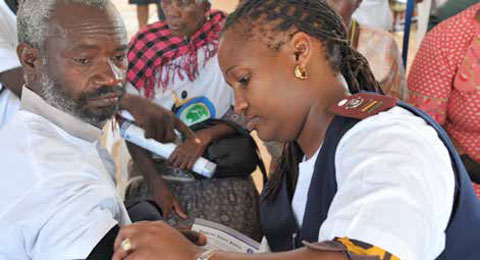 Government’s strategy to achieve better health outcomes include improving the quality and accessibility of health services by phasing in of the National Health Insurance (NHI).
Government’s strategy to achieve better health outcomes include improving the quality and accessibility of health services by phasing in of the National Health Insurance (NHI).
The NHI is a financing system that will make sure that all citizens of South Africa (and legal long-term residents) are provided with essential health care, regardless of their employment status and ability to make a direct monetary contribution to the NHI.
Over the next five years government plans to:
- Improve health care and reduce waiting times in the public sector, supported through the newly established Office of Health Standards Compliance and adherence to a Patients’ Charter.
- Expand and re-engineer primary healthcare, including municipal Ward-based Outreach Teams and school health services.
- Expand district-based piloting of NHI services.
- Promote healthy lifestyles and encourage regular screening for non-communicable diseases.
- Reduce healthcare costs.
- Appoint more staff for health, revitalisation of nursing colleges and expanded professional health training.
- Invest in health management improvements and leadership, including reform of the governance, funding and management of central hospitals as national referral facilities.
- Improve health facility planning and accelerate infrastructure delivery
- Strengthen implementation of HIV and AIDS, and tuberculosis prevention and management programmes.
- Expand access to sexual and reproductive health by improving the availability of diverse contraception methods.
- Reduce unwanted pregnancies with a special focus on teenage pregnancies
- Implement the African Union (AU)- inspired Campaign on Accelerated Reduction of Maternal and Child Mortality in Africa.
To expand health care services over the next five years, government will:
- Build 213 clinics and community health centres and 43 hospitals.
- Refurbish over 870 health facilities in 11 NHI pilot districts.
- Double the annual training of doctors locally and abroad to 2 000 a year.
- Double the number of people on antiretrovirals from the present 2,4 million to a projected 5,1 million.
- Intensify TB screening and treatment programmes for vulnerable groups, including 150 000 inmates of correctional services facilities, 500 000 mineworkers and an estimated 600 000 people living in mining communities.
- Vaccinate all girls in Grade 4 against the human papilloma virus, to significantly reduce their risk of acquiring cervical cancer in future.
Some of the health interventions that government aims to achieve by 2019 include:
- Raising life expectancy at birth to 63 years.
- Decreasing the under-five mortality rate from 41 in 2012 to 23 per 1 000 live births.
- Decreasing the infant mortality rate from 27 in 2012 to 18 per 1000 live births.
- Lowering the maternal mortality rate from 269 to below 100 per 100 000 live births.
Social protection system
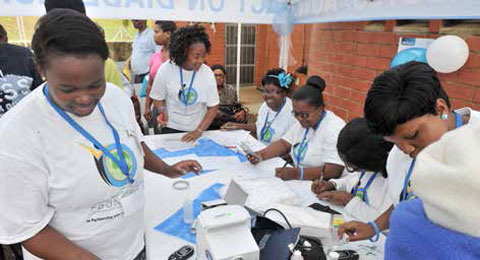 Government aims to achieve the following key targets:
Government aims to achieve the following key targets:
- An essential age- and developmentally stage-appropriate package of quality ECD services is available and accessible to all young children and their caregivers by 2024.
- Universal access (at least 95 per cent of eligible people) to social assistance benefits by 2019, notably the child support grant, disability grant and old age pension.
Special attention will be paid to improving capacity in the areas of forensics, crime investigations, and preventing crimes against women and children.
Government will ensure that repeat offending or re-offending is reduced by increasing and improving rehabilitation programmes for offenders, improving the integration of parolees into communities and ensuring fewer parolee or probationer violations. Coordinated initiatives to make the criminal justice system more efficient and effective will continue to be prioritised.
The South African Police Service’s response to reported crime incidents will be enhanced by improving reaction times, investigations, pre-trial processes and case cycle times.
South Africa’s borders will be more effectively defended, protected, secured and well-managed by, among other things, taking measures to reduce illegal cross-border activities.
Over the next five years, government aims to improve conviction rates for serious corruption cases. Anti-corruption legislation will also be revised to provide for more stringent penalties, to protect whistle-blowers – including those in the private sector – and to strengthen the independence of anti-corruption agencies to protect them from political pressure.
The Special Investigating Unit, the Anti- Corruption Task Team, the Asset Forfeiture Unit and the Hawks will continue to combat corruption in society broadly and in the public sector.
Fighting corrupiton & crime
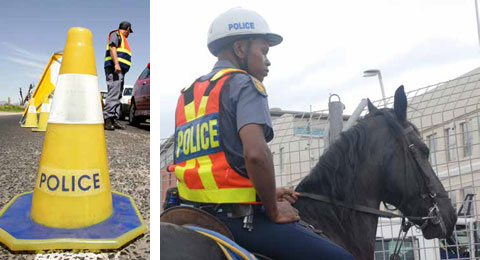 Government will tackle crime by:
Government will tackle crime by:
- Reducing the number of contact crimes.
- Increasing the proportion of citizens who feel safe walking alone, during the day or at night, as measured in official surveys.
- Increasing the proportion of households that are satisfied with police services in their area, and with the way courts deal with the perpetrators of crime.
- Improving citizens’ perceptions of levels of crime.
- Improving South Africa’s ranking on the Transparency International Corruption Perception Index.
To achieve these targets, government will work to reduce levels of contact crime; ensure an efficient and effective criminal justice system, effectively defend and secure South Africa’s borders; tackle cyber-crime; ensure domestic stability and secure the identity of all persons in South Africa.
Rural development & land reform
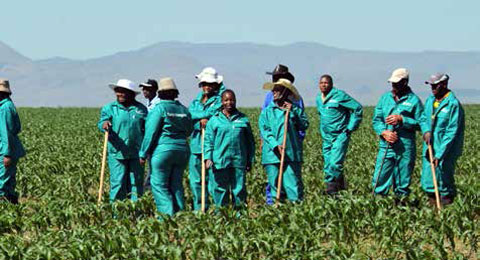 To strengthen food security and agricultural competitiveness, and lift marginalised rural households out of poverty, especially in former homeland areas, government aims to achieve the following over the next five years:
To strengthen food security and agricultural competitiveness, and lift marginalised rural households out of poverty, especially in former homeland areas, government aims to achieve the following over the next five years:
- Increase the percentage of productive land owned by previously disadvantaged individuals from 11,5 per cent in 2013 to 20 per cent.
- Ensure that 7,2 million hectares (ha) of land in total will have been transferred to previously disadvantaged individuals and is being used productively (as compared to four million ha by 2013).
- Reduce the percentage of households who are vulnerable to hunger from 11,4 per cent in 2013 to less than 9,5 per cent.
- Reduce the percentage of the population living below the lower bound poverty line (R443 in 2011 prices) from 32,3 per cent to below 22 per cent.
- Reduce rural unemployment from the current 49 per cent to less than 40 per cent.
Important interventions:
- Citizen participation in local government processes will continue to be promoted.
- Cooperative governance arrangements will be strengthened to better support and empower municipalities.
- A long-term approach will be taken to skills development and capacity building for the local government sector.
- Institutional problems will be addressed to improve the quality of municipal administrative and management practices, including human resources and recruitment practices, supply chain and financial management, and anti-corruption initiatives.
A better Africa & world
- Government aims to increase foreign direct investment into South Africa and increase the country’s exports.
- Government will continue to promote peace and security, strengthen regional integration, significantly increase intra- African trade and champion sustainable development in Africa.
- Government will increase the number of foreign visitor arrivals to more than 15 million annual foreign visitor arrivals by 2017, and increase the contribution of tourism revenue to the economy to more than R125 billion by 2017.
- Government will also advance developmental cooperation and integration to achieve industrial development, as well as infrastructure development and market integration by contributing to the revision of the Southern African Development Community Regional Integrated Strategic Development Plan.
- The Draft Phase 1 Trilateral Free Trade Agreement (FTA) will be successfully concluded to enable greater intra-African trade, industrialisation and infrastructure development. Government will also contribute to the review of the role and functioning of the Southern African Customs Union.
- South Africa will continue supporting and executing decisions of the AU and its structures, including the African Court for Human and People’s Rights. The country will also increase the uptake of South Africa’s quota of posts in the AU Commission and AU structures to 60 per cent.
- Government will continue to contribute to the implementation of New Partnership for Africa’s Development programmes and plans. In addition government will ensure that key South African positions are reflected in the processes leading up to the establishment of the Continental FTA.
- Government will also continue to promote mutually beneficial South-South cooperation by using membership of and engagements with formations and groupings of the South.
- Government will aim to harness the economic strength of countries and groupings of the South by increasing the number of South Africa’s bilateral economic cooperation agreements from 49 to 59. It will also continue to promote mutually beneficial relations with countries of the North.
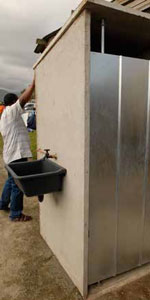 Adequate human settlements & basic services
Adequate human settlements & basic services
To achieve the vision of sustainable human settlements and an improved quality of household life, government’s priorities over the next five years include:
- Adequate housing and improved quality living environments, with approximately 1,4 million more households living in new or improved housing conditions by 2019.
- A functional and equitable residential property market with a target of 110 000 new housing units delivered in the affordable gap market by 2019.
- Enhanced institutional capabilities for effective coordination of spatial investment decisions, with a target of 49 municipalities assigned or accredited with the housing function.
- The title deeds for all 563 000 new subsidy units as well the backlog of 900 000 title deeds in the integrated residential housing programme will be transferred over the next five years.
- Informal settlement upgrading will be expanded to cover 750 000 households, ensuring basic services and infrastructure in some 2 200 informal settlements.
Housing communities
- In mining communities, housing solutions will be sought through partnership between the State, municipalities, employers and financial institutions. Within the public service and in the private sector, improved access to affordable housing could be supported through remuneration allowances or credit enhancement.
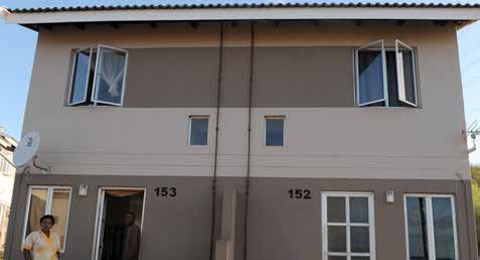
Ensuring affordable housing
- Government will tackle the challenges of the affordable housing market, barriers to more rapid residential construction will be addressed, together with support for broadening access to housing credit, particularly for first-time home-buyers.
Effective local government
To ensure that communities have sustainable and reliable access to basic services, government aims to achieve the following by 2019:
- An increase in the percentage of house households with access to a functional water service from 85 per cent in 2013 to 90 per cent.
- An increase in the percentage of households with access to a functional sanitation service from 84 per cent in 2013 to 90 per cent, including eliminating bucket sanitation in the formal areas.
- 1,4 million additional households will be connected to the grid between 2014 and 2019, and 105 000 additional non-grid connections.
- Provide an income support to the unemployed by expanding the CWP to reach one million participants.
- An increase in the level of public trust and confidence in local government from 51 per cent in 2012 to 65 per cent in 2019, as measured by the IPSOS survey. • An improvement in overall municipal audit outcomes, with at least 75 per cent of municipalities receiving unqualified audits.
Social cohesion & national building
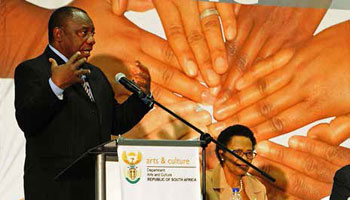 To promote a socially inclusive society, government will over the next five years ensure that the:
To promote a socially inclusive society, government will over the next five years ensure that the:
- Proportion of people of the opinion that race relations are improving rises to 65 per cent (from 40 per cent in 2011).
- Social cohesion index rises to 90 per cent in 2019 (from 80,4 per cent in 2011).
- Active citizenship index rises to 85 per cent in 2019 (from 79 per cent in 2011).
- Number of people over 18 that belong to a charitable organisation rises to 10 per cent in 2019 (from 5 per cent in 2011).
Make your voice heard
Make your voice heard sadminDo you have a story to tell about what life was like in apartheid South Africa or during the transition to democracy?
 If you do, the "Tell Your Story Campaign" gives you the perfect platform to reflect on your experiences.
If you do, the "Tell Your Story Campaign" gives you the perfect platform to reflect on your experiences.
The campaign, initiated by Government Communications (GCIS), as part of the 20 Year Celebrations, is about getting all South Africans, to share their experiences of apartheid and democracy. This campaign aims to provide the platform for South Africans to share experiences, transcend their differences and build a unified nation.
The “Tell Your Story” campaign has the support of a range of organisations and will begin and run throughout September. The Department of Arts and Culture (DAC) has adopted the campaign as part of its Heritage Month theme “Celebrating 20 Years of Democracy: Tell Your Story that Moves South Africa Forward”.
Government, business and civil society are also planning a range of activities that will get South Africans to reflect on the past, appreciate the present and plan for the future. Our journey to freedom and democracy has not been easy. Apartheid divided our nation.
South African people of colour were stripped of their basic human rights and dignity and forced off their land into homelands or townships. Laws were introduced that restricted freedom of movement. Black and white people were not able to mix socially. Mixed marriages were forbidden. Political parties were banned. Thousands were arrested and sent to jail for their beliefs. Every South African can tell a story about this time. Even those who were not born in 1994 have heard about how the country celebrated when democracy was achieved.
Democracy has brought change, but today, many South Africans remain divided by race, class, gender and/or their cultural backgrounds. Many feel that they have not had the opportunity to talk about the difficulty of growing up in apartheid South Africa, or what the democratic change has meant for them.
GCIS is encouraging you to Tell Your Story. Write in or send voice or video clips. Tell us about your experience of apartheid. What changes have you seen since 1994 and how can we make South Africa a place that all can call home?
Young people are invited to share the story of what the gains of democracy has brought them. You can also interview someone who has a fascinating story to tell and share it.
South Africans have already begun telling their stories, click here to read.
We are also on Facebook or Twitter If you are interested in posting one of your stories, please post or email these to us on: electronic@gcis.gov.za
Tell your story this Heritage Month
Tell your story this Heritage Month sadminThis September South Africans from all walks of life are encouraged to celebrate Heritage Month by paying homage to their past and sharing their stories of freedom and democracy.
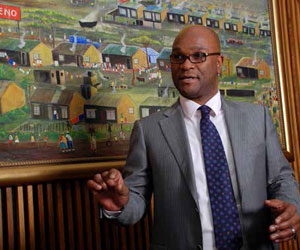 This year’s theme is ‘Celebrating 20 Years of Democracy: Tell Your Story that Moves South Africa Forward.’
This year’s theme is ‘Celebrating 20 Years of Democracy: Tell Your Story that Moves South Africa Forward.’
The theme aims to reconnect the nation and celebrate its rich and diverse collective heritage.
According to Arts and Culture Minister Nathi Mthethwa, the purpose of Heritage Day, commemorated on 24 September, and Heritage Month as a whole is to celebrate national identity, nation building, social cohesion and, above all, freedom of expression.
The Minister has dedicated the next five years to highlighting commemorative days like Heritage Day, Freedom Day and more. The department will lead and coordinate these special days and months to promote constitutional values, cultural transformation and an active citizenry.
This year’s Heritage Day event will take place in Mahikeng, North West.
Events building up to Heritage Day will include an exhibition, National Book Week and dialogues. In addition, national, provincial and local government will offer services such as applications for and tracking of identity documents, applications for social grants, mobile health clinics and career guidance for learners.
“The history of a nation is best captured and reflected in the lives and experiences of its people. We are an African people and our stories tell how far we have come,” added the Minister.
Thabong police station shines in service delivery
Thabong police station shines in service delivery sadminThe Thabong police station, situated about 140 kilometres from Bloemfontein, is the leading police station in South Africa.
The Southern Sotho word ‘thabong’ means a place of happiness, which the police members at the station try to emulate when serving the public.
The station won R15 000 prize money in the South African Police Service Excellence Awards, which will go towards buying new equipment for the community service area.
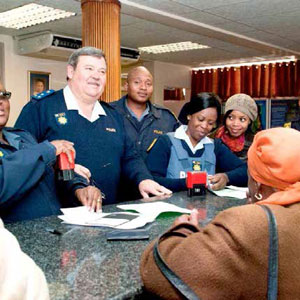 The man behind the success of the police station is Station Commander Cois Muller who says he has always wanted to be a policeman and serve the public.
The man behind the success of the police station is Station Commander Cois Muller who says he has always wanted to be a policeman and serve the public.
Muller has been at the police station since 2009 and has made it his goal to ensure that the people of Thabong are served by policemen and women who are happy and efficient.
Besides being the leading police station in the country, the Thabong police station has been scooping provincial awards for the past three years for being the finest police station in the Free State.
Mojake Moholo is a community member of Thabong.
He says the staff of the police station is friendly and quick to help.
“When visiting other police stations, service usually takes time. When I come here I know I will get the service I need. The staff give you time to state your problem and try to assist you in whatever way they can. I am proud that a police station in my community is the best in the country.”
The management of the Thabong police station uses several methods to fight crime, which include mobilising the community.
Brigadier Muller and his team visit crèches, schools, the elderly, shack burn victims and taverns informing the community on the dangers of crime and how to work with police to make Thabong a better place.
Lieutenant Colonel Ntepe Motarafi, police officer working at the station, says she is proud of what the station has managed to achieve and also sees it as a learning curve in her career.
Lieutenant Colonel Motarafi works in the Community Service Centre and says she thinks the centre is the most important part of the police station because of its direct contact with the community.
She adds that working with the community can be a challenge but she enjoys it.
“What the public does not understand is that in order to curb crime they need to work with us. If a crime is committed they need to come forward with information to assist the police,”said Motarafi.
Some of the issues the police station deals with include illegal gold dust mining, illegal immigrants and alcohol abuse, which fuels other crimes.
The illegal immigrants come from the neighbouring countries such as Lesotho, Mozambique and Malawi, according to Brigadier Muller.
“The mines have all closed down and you find people digging for gold dust which they mix with chemicals and it produces a small stone size gold,” says Muller.
The police station has a staff complement of 331 police officers servicing a population of 135 569 people.
Thabong has 482 trained community patrollers, who wear reflector jackets, working in 12 wards and form part of the Community Policing Forum (CPF).
Serake Leeuw, the chairperson of the CPF, said keeping Thabong safe was also the responsibilty of the community and should not be left to the police alone.
“If we want to clamp down on crime we have to work with the police. I have been in the CPF since 2011 because I think it is my responsibility too to live in a safe environment. I am very proud of the working relationship that we have with the station and we are working hard in eradicating crime in the area,” said Leeuw.
Innovative device to fight crime
Innovative device to fight crime sadminWhen Thuli Mthethwa’s family was violently attacked at their home in Tembisa, east of Johannesburg, she gave up her job as a software developer to design an alarm device that would benefit the community.
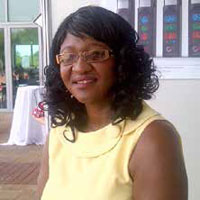 Mthethwa started the Memeza Women Empowerment Project, which developed a small costeffective key ring that is both a personal safety alarm and a household community safety alarm.
Mthethwa started the Memeza Women Empowerment Project, which developed a small costeffective key ring that is both a personal safety alarm and a household community safety alarm.
Once the Memeza personal alarm is activated, neighbours and police are alerted that help is needed immediately.
Mthethwa describes the personal alarm as one of the simplest and most effective alarm systems. It is operated by simply pulling the lanyard, with the alarm emitting a warning at 140 decibels.
The Memeza household community alarm emits a unique three-phased siren to alert the community of intruders.
Once activated, the house is easily identified by a flashing red light and alert SMSes are sent to the cellphones of the local sector police, community crime initiatives, patrollers and family members. The household alarm and its backend system are being finalised and testing has been underway since January 2014.
 “We have engaged with various community policing forums and the SAPS and there are discussions to roll out the Memeza system in communities across each of the Gauteng metropolitan municipalities. Tooling development is now at an advanced stage and we hope to reach commercialisation later this year,” explained Mthethwa.
“We have engaged with various community policing forums and the SAPS and there are discussions to roll out the Memeza system in communities across each of the Gauteng metropolitan municipalities. Tooling development is now at an advanced stage and we hope to reach commercialisation later this year,” explained Mthethwa.
The Memeza system has a number of features that make it unique. It is the first pay-as-yougo alarm system with airtime pooling to reduce monthly airtime costs for the alarm owner; it has a long battery life; it can be charged using solar energy at local community centres and it is cellphone control enabled.
The household community alarm is able to log crime statistics to a private SAPS database and provide information. This is useful for sector commanders and station managers who will be able to gather information per sector, town and province.
In March this year 10 000 personal alarm devices were distributed to women and children from Diepsloot, Tembisa, Soshanguve, Eldorado Park, Ivory Park, and Ebony Park. The donation was from the Memeza Women Empowerment Project and was made possible by funding from the National Lottery Board. Mthethwa is one of the 54 entrepreneurs on the Maxum Programme at The Innovation Hub and has been part of the programme for two years.
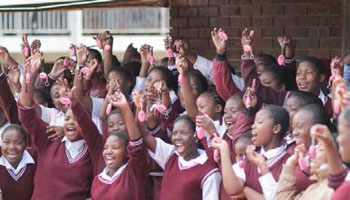 The Innovation Hub is Africa’s first accredited science and technology park and an entrepreneurship intervention designed to accelerate the growth of innovative knowledge and technology-based enterprises in Gauteng.
The Innovation Hub is Africa’s first accredited science and technology park and an entrepreneurship intervention designed to accelerate the growth of innovative knowledge and technology-based enterprises in Gauteng.
“It pleases me to see a smart approach to complex socio- economic challenges. Memeza and The Innovation Hub are working closely together to produce a system that can make huge difference to the communities where it is used,” said McLean Sibanda, CEO of The Innovation Hub.
The Maxum Programme comprises the Maxum Innovation Factory, which is a preincubation programme, designed to support entrepreneurs over a six to nine month period to develop bankable business plans.
*Captain Karien van der Merwe works for the South African Police Service.
Jobs: Department of Justice & Constitutional Development
Jobs: Department of Justice & Constitutional Development sadmin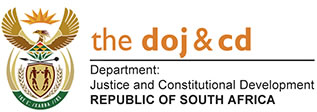 DEPUTY DIRECTOR: FEATURE WRITER
DEPUTY DIRECTOR: FEATURE WRITER
REFERENCE: 14/242/PEC
PACKAGE: R532 278 – R627 000 per annum. The successful candidates will be required to sign a performance agreement.
ENQUIRIES: Mr Cecil Sibiya (012) 357-8054
COURT MANAGER
REFERENCE NR: 76/14/NC
SALARY: R270 804.00 – R 327 126.00 per annum. The successful candidate will be required to sign a performance agreement.
ENQUIRIES: Ms S. Ruthven (053) 8390000
ASSISTANT DIRECTOR: MEDIA RESEARCH
REFERENCE: 14/226/PEC
SALARY: R270 804 – R318 984 per annum (All inclusive). The successful candidate will be required to sign a performance agreement.
ENQUIRIES: Mr M Motsieloa (012) 315 1668
ASSISTANT DIRECTOR: BIDS AND NEGOTIATIONS
REFERENCE: 14/248/CFO
SALARY: R270 804 - R318 984 per annum. The successful candidate will be required to sign a performance agreement.
ENQUIRIES: Ms. E. Zeekoei (012) 315 1436
ESTATE CONTROLLER, (02 POSTS)
REFERENCE: 14/245/MAS: CAPE TOWN (1)
REFERENCE: 14/247/MAS: GRAHAMSTOWN (1)
SALARY: R141 339 per annum. (Salary will be in accordance with OSD determination). The successful candidate will be required to sign a performance agreement.
ENQUIRIES: Mr. S. Maeko (012) 315 1996
SENIOR LEGAL ADMINISTRATION OFFICER: (MR-6)
REFERENCE: 14/249/CLO
SALARY: R340 716 – R828 138 per annum. (Salary will be in accordance with OSD determination). The successful candidate will be required to sign a performance agreement.
ENQUIRIES: Ms K. Ngomani (012) 357 8661
MAINTENANCE OFFICER: MR-1 – MR-5
(2 POSTS) (CONTRACT POST ENDING 31 MARCH 2015)
REFERENCE NR: 53/14/NC (1)
REFERENCE NR: 54/14/NC (1)
SALARY: R141 339.00 – R 662 397.00 per annum. (Salary will be determined in accordance with experience as per OSD determination).The successful candidate will be required to sign a performance agreement.
ENQUIRIES: Mr. J. Tope (053) 839 0000
CLOSING DATE FOR ALL POSTS IS 22 SEPTEMBER 2014
NOTE: Interested applicants may visit the following website: www.justice.gov.za or www.dpsa.gov.za to view the full job specification of the above positions. Applications must be submitted on Form Z83, obtainable from any Public Service Department or on the internet at www.gov.za. A Z83 & CV must be accompanied by certified copies of qualifications and identity document. A drivers license must be attached if indicated as a requirement. A SAQA evaluation report must accompany foreign qualifications. Applications that do not comply with the above mentioned requirements will not be considered. The Department of Justice is an equal opportunity employer. In the filling of vacant posts the objectives of section 195 (1) (i) of the Constitution of South Africa, 1996 (Act No: 108 of 1996), the Employment Equity imperatives as defined by the Employment Equity Act, 1998 (Act No: 55 of 1998) and relevant Human Resources policies of the Department will be taken into consideration. Shortlisted candidates will be subjected to a personnel vetting process. Correspondence will be limited to short-listed candidates only. If you do not hear from us within 3 months of this advertisement, please accept that your application has been unsuccessful. The department reserves the right not to fill these positions. Women & people with disabilities are encouraged to apply and preference will be given to them.
Jobs: National Prosecuting Authority
Jobs: National Prosecuting Authority sadminNational Prosecuting Service
 POST: SENIOR PUBLIC PROSECUTOR
POST: SENIOR PUBLIC PROSECUTOR
SALARY: R 713 583.00 per annum (Total Cost Package) to R 1 115 409.00 per annum (Total Cost Package) (Level CM-1)
CENTRE: CPP: Polokwane X2 (Tzaneen; Phalaborwa) (Recruit 2014/334)
POST: SENIOR STATE ADVOCATE
SALARY: R 713 583.00 per annum (Total Cost Package) to R 1 115 409.00 per annum (Total Cost Package) (Level LP 9)
CENTRE: DPP: South Gauteng (Re-Advertisement) X3 (Recruit 2014/335); DPP: Mthatha (Recruit 2014/355)
POST: STATE ADVOCATE
SALARY: R 554 025.00 per annum (Total Cost Package) to R 919 116.00 per annum (Total Cost Package) (Level LP-7 to LP-8)
CENTRE: DPP: Cape Town (Recruit 2014/336)
POST: REGIONAL COURT CONTROL PROSECUTOR
SALARY: R614 883 per annum (Total Cost Package) to R 1 005 009.00 per annum (Total Cost Package) (Level SU-3)
CENTRE: CPP: Mitchell’s Plain (Recruit 2014/337); CPP: Polokwane (Recruit 2014/338); CPP: Modimolle (Recruit 2014/339)
POST: HEAD CONTROL PROSECUTOR 2
SALARY: R 367 047.00 per annum (Excluding Benefits) to R 865 968.00 per annum (Total Cost Package) (Level SU-1 to SU-2)
CENTRE: CPP: Modimolle (Phalala) (Recruit 2014/340); CPP: Pietermaritzburg (Recruit 2014/341)
POST: REGIONAL COURT PROSECUTOR
SALARY: R 367 047.00 per annum (Excluding Benefits) to R 865 968.00 per annum (Total Cost Package) (Level LP-5 to LP-6)
CENTRE: CPP: Modimolle (Thabamoopo) (Recruit 2014/342); CPP: Polokwane (Naphuno) (Recruit 2014/343); CPP: Ladysmith X2(Newcastle; Estcourt) (Recruit 2014/344); CPP: East Rand (Recruit 2014/354)
POST: DISTRICT COURT CONTROL PROSECUTOR
SALARY: R 367 047.00 per annum (Excluding Benefits) to R 865 968.00 per annum (Total Cost Package) (Level SU-1 to SU-2)
CENTRE: CPP: Ladysmith (Recruit 2014/345)
Corporate Services
SECURITY MANAGEMENT SERVICES
POST: ASSISTANT DIRECTOR: OPERATIONAL PLANNING AND SUPPORT
SALARY: R 337 998.00 per annum (Excluding Benefits) (Level 10)
CENTRE: Pretoria (Recruit 2014/351)
Human Resources Management and Development
POST: ASSISTANT DIRECTOR: LABOUR RELATIONS
SALARY: R 337 998 per annum (Excluding Benefits) (Level 10)
CENTRE: Pretoria: Head Office X2 (Recruit 2014/352); Bloemfontein (Recruit 2014/353)
Asset Forfeiture Unit
POST: SENIOR STATE ADVOCATE
SALARY: R 713 583.00 per annum (Total Cost Package) to R 1 115 409.00 per annum (Total Cost Package) (Level LP-9)
CENTRE: Durban (Recruit 2014/347); East London (Recruit 2014/348); Polokwane (Recruit 2014/349)
POST: STATE ADVOCATE
SALARY: R 554 025.00 per annum (Total Cost Package) to R 919 116.00 per annum (Total Cost Package) (Level LP-7 to LP-8)
CENTRE: Nelspruit (Recruit 2014/350)
Specialised Commercial Crime Unit
POST: DEPUTY DIRECTOR OF PUBLIC PROSECUTIONS
SALARY: R 895 677.00 per annum (Total Cost Package) (SMS LEVEL 13)
CENTRE: Cape Town (Recruit 2014/346)
CLOSING DATE: 15 September 2014
NOTE: For full view of vacancy specifications, applicants may visit the NPA’s website at www.npa.gov.za click on the Careers@NPA and ensure that you follow the correct link to the positions. For your application to be accepted: Applications must be submitted on a Z83, obtainable from any Public Service department or on www.npa.gov.za and must be completed in full i.e. both pages ofthe Z83 must be completed. If the Z83 is not completed as prescribed your application will not be accepted. CVs without a Z83 will not be accepted. Handwritten Z83 must be completed in BLOCK LETTERS.Each post has a different recruitment number and it must be completed on the application form. Applications without the correct or without a recruit number will no be processed. Should you apply for more than one post, a separate application for each post must be submitted. Applications with multiple posts and recruitment numbers will not be accepted. Section B ofthe application form requiring personal information must be completed as the NPA uses the information for Employment Equity and other reporting purposes. The NPA is an equal opportunity employer. People with disabilities will be given preference and encouraged to apply. In the filling of vacancies, the objectives of Section 195(1)(i) of the Constitution of the Republic of South Africa,1996, and in particular the Employment Equity Act,1998 (Act 55 of 1998) and the NPA Employment Equity Strategy 2016, will take highest preference in selection of suitable candidates. All applications must reach Affirmative Portfolios on/or before the closing date. No late applications will be accepted/processed. The NPA /Affirmative Portfolios cannot be held responsible for postal or server delays. Applicant’s attention is drawn to the fact that Affirmative Portfolios uses an Electronic Response Handling System in terms of e-mailed applications. Please DO NOT contact Affirmative Portfolios directly after you have e-mailed your applications to enquire if your application(s) have been received. If you have not received an acknowledgement of receipt within one week after the closing date then you can contact Affirmative Portfolios. Only copies of required qualifications and other listed documents as per the advert, preferably certified, must be included with your application. The NPA reserves the right not to fill any particular position. If you do not hear from us within (3) three months from the closing date of the advert, please accept that your application was unsuccessful. Successful candidates will be subjected to security clearance up to a level of Top Secret. Appointment to this position will be provisional, pending the issue of security clearance. Fingerprints will be taken on the day of the interview.
Applications must be submitted to the relevant Recruitment Response E-mail or fax as stated on the full advert.
Or posted to:
Affirmative Portfolios
P.O. Box 785724
Sandton
2146
Maponya Mall Thusong Centre at the forefront of service delivery
Maponya Mall Thusong Centre at the forefront of service delivery sadminOn average the Maponya Mall Thusong Service Centre receives about 22 000 clients monthly requiring government services, which range from applying for identity documents (IDs), entrepreneur information and employment opportunities.
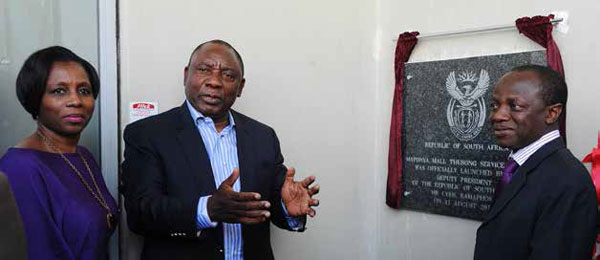 In 2013, alone the centre had 243 460 visitors with the Departments of Home Affairs, Labour and the Gauteng Department of Roads and Transport being the most popular. The Home Affairs office had 91 777 visits, the Department of Labour had 79 744 visits and the Gauteng Department of Roads and Transport had 54 532.
In 2013, alone the centre had 243 460 visitors with the Departments of Home Affairs, Labour and the Gauteng Department of Roads and Transport being the most popular. The Home Affairs office had 91 777 visits, the Department of Labour had 79 744 visits and the Gauteng Department of Roads and Transport had 54 532.
A Thusong Service Centre is a one-stop service centre providing information and services to communities in an integrated manner. Each Thusong Centre is modified to suit the needs of a particular community.
Other offices at the centre include the Gauteng Enterprise Propeller, the National Youth Development Agency and a Professional Job Centre.
Everyday the centre is abuzz with the young and old seeking information. At the entrance of the centre queues are managed by tight security and are separated according to the needs of the individuals.
The NYDA office offers services such as career guidance, job preparation, job placement, business development, a grant programme between R1 000 to R100 000 along with non-financial support in running and starting a business. The most popular service is business development.
According to Tshepo Manyama, who manages the NYDA office, between 700 and 1 000 people receive services in a month. He says the office also monitors the progress of the entrepreneurs after they have received assistance from NYDA.
Gauteng Finance also has an office within the Thusong Centre, known as the Professional Job Centre, which assists community members with drafting their CVs and searching for employment electronically.
Nombulelo Skosana, who works in this department, says each person is given 30 minutes to use a computer to look for employment. If the centre is not busy, they can use the computer as long as they need to.
The Professional Job Centre gets between 500 and 1 300 visitors a month.
Ruth Ntathe, who manages the Home Affairs office, says the services her office offers include re-issuing of birth certificates, application for IDs and temporary IDs, passports and unabridged birth certificates.
Ntathe says in the 2012/13 financial year, the Home Affairs office had about 7 000 visitors a month.
“Since the centre was so busy, the office was renovated to make the service quicker and faster. The seating area of the Home Affairs office was upgraded from four counters to 23 and one cashier along with expanding the seating to 40 people.”
She adds that since the renovations there are fewer queues and people are helped faster.
Humphrey Manene, from the Department of Labour office, says UIF applications, people applying to be medically boarded and those who were injured on duty and people facing problems at work are the most popular services.
“We have about 80 000 people visiting the office and the community gives us a positive response because the Thusong Centre is closer to their homes.”
He adds that they also get visits from people coming from as far as Benoni, Sandton and Springs because they know they will get assistance from the Maponya Mall Thusong Centre.
Katlego Letsholo, who works at the Gauteng Department of Roads and Transport office, says they offer services such as renewal of licence discs, professional driving permits and license renewals.
In June this year the office had about 3 000 visitors and it takes less than 10 minutes for customers to get assistance, adds Letsholo.
Sani Molefe, who manages the Gauteng Enterprise Propeller (GEP) office, says the GEP is an agency of the Department of Economic Development in Gauteng.
“We were established to provide financial and non-financial services to SMMEs and cooperatives in the province.
Our objective is to make sure that we give assistance that supports the growth and development of SMMEs in the province.” The GEP, which caters for financing needs up to R5 million, offers enterprises who meet certain criteria funding, subject to the enterprise proving financial viability and the ability to repay the loan.
The GEP assists up to 200 people a month and their services are relevant to SMME development and are interlinked.
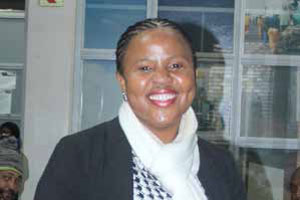 Thusong Service Centre manager Hlengiwe Cele says what makes the centre successful is teamwork, an emphasis of customer care and adhering to Batho Pele principles.
Thusong Service Centre manager Hlengiwe Cele says what makes the centre successful is teamwork, an emphasis of customer care and adhering to Batho Pele principles.
“We do monitor and evaluate our performance and use data collected to make informed decisions or to improve service delivery.”
The main function of Thusong Service Centres is to address social and economic factors, which limited access to information, services, and participation by citizens, as they had to travel long distances to access these services.
In March 2012 there were 171 Thusong Service Centres across the country, providing access to information and services to citizens.
Typical services found in these centres include those offered by the Departments of Home Affairs, Labour, Social Development and Health, as well as the South African Social Security Agency and GCIS.
The Post Office, libraries, agricultural extension offices, municipal services, South African Police Service, NGOs, and community-based organisations can also be found in Thusong Centres.
Fast, effective and efficient service
Fast, effective and efficient service sadminAfter spending the day at the Maponya Mall Thusong Service Centre we decided to hear from users about their experiences at the centre.
 Gladys Sani,
Gladys Sani,
44
Diepkloof Zone 3
“I came to the centre to collect my driver’s licence at the Department of Roads and Transport and I must say the staff here are kind, patient and know good customer service. It took me a few minutes to get assistance and the security guards monitoring the lines are helpful as they direct you to the correct line. I am very happy with the service here and would come back to use more of their services. A lot has improved within government in 20 years and public servants now pay attention to the public.”
 Marcus Matlala
Marcus Matlala
18
Mapetla
“I heard about the centre from a friend, who recommended it to me. I came here today to apply for a smart card ID. The officials here are kind and patient as they take their time to help us and attend to our queries in the best way possible. Today as South Africans we are able to share and acquire information easily unlike in the past.”
 Khotso Mzolo
Khotso Mzolo
23
Klipspruit Ext 2
“The Thusong Centre brings all the services closer to the community and makes it easy for people to access of information. The officials here are friendly and help us a lot. I came here to register my profile on the government database. The centre provides us with free internet connection, which we use to apply for and browse the government circulars for job advertisements. As a youth I am happy to be celebrating 20 Years of Freedom as government now puts most of its focus on job creation for unemployed youth.”
Elizabeth Molefe
63
Vlakfontein Ext 3
“Since I started coming here in January this year I have not experienced any troubles; the staff have been very helpful. I came to the centre to apply for Unemployment Insurance Fund at the Department of Labour. The staff member that assisted me was clear and explained the process to me and I received my first payment in June.”
Technology boosts learners’ maths results
Technology boosts learners’ maths results sadminFor years 11-year-old Awande Mhlongo and his classmates drew circles and ticks on their books trying to answer mathematics problems. When they ran out of pages, they would use their fingers to get to the answer.
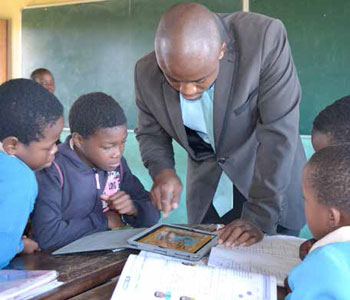 Today Mhlongo, along with some of his classmates at Gobamahlamvu Primary School in Umlalazi, KwaZulu- Natal, is one of the top mathematics pupils in his class thanks to the iSchoolAfrica Rural Development Programme.
Today Mhlongo, along with some of his classmates at Gobamahlamvu Primary School in Umlalazi, KwaZulu- Natal, is one of the top mathematics pupils in his class thanks to the iSchoolAfrica Rural Development Programme.
The project takes technology to some of the most under resourced rural schools in the country.
n 2009, the Department of Rural Development and Land Reform (DRDLR) started taking information and communication technologies (ICTs) to rural communities in the form of ICT centres that provide access to government services, learning and training material, employment opportunities and communication.
DRDLR works with iSchoolAfrica, a private company, to develop and roll out the iSchool Africa Rural Development Programme. It has supported at least 77 rural schools nationally with 40 iPads per school.
One of those schools is Mhlongo’s. He wants to be a doctor and his classmates regard him as a “genius”. They sit quietly around him as he uses the iPad to do his calculations.
“Awande helps me with maths using the iPad. The iPads have helped us because we do not use our hands to count anymore,” says 11-year-old Sfundo Zwane, who wants to be a policeman.
Sbonelo Makhoba, 11, adds that they also use the iPads to take pictures and videos.
iSchoolAfrica and its partners - the DRDLR and the Council for Scientific and Industrial Research (CSIR) - visited schools in KZN that have benefited from the project.
iSchoolAfrica Project Director, Michelle Lissoos, describes the project as the “beginning of a model that works”.
“We often meet in offices with our partners but the critical part is engaging with schools themselves. We make it a priority to get feedback….. the project is changing learning in rural areas,” she says.
Lissoos is impressed as mathematics teacher Lungisa Khanyile uses an iPad to project sums onto the wall instead of writing on the board. He says the attention Grade 4 learners give their studies has improved since they started using iPads.
Khanyile says another advantage is that when there is a shortage of books, teachers scan the book and project it on the wall using the iPad so all learners can follow.
Principal of Gobamahlamvu Primary School Thobi Thwala says the iPads have helped boost literacy and numeracy in her schools.
“We were waiting for computers but we got the iPads which are more interactive. The learners enjoy using them,” she says.
About three kilometres from Gobamahlamvu, at Samungu Primary School, Esmeralda Reid from the DRDLS’s Information and Communications Technology Directorate is captivated by Muzi Zondi’s teaching methods. Zondi, who teaches English, asks his pupils to name and then describe emotions. While one pupil demonstrates the emotion, his classmates capture a picture of it on the iPad. The demonstrations spark outbursts of laughter among the officials and classroom.
Zondi says that using iPads increases the focus of learners and he makes sure that they are used in line with the teaching curriculum.
The iPads have sparked 10-year-old Lindokuhle Mthembu’s interest in mathematics.
“I also like reading from the iPad,” the aspiring doctor.
Reid interacted with the pupils and witnessed first-hand how the project is shaping unfortuthe lives and education of the pupils.
“The schools are happy and they are able to do things digitally now,” she says.
CSIR Operations Manager Hennie Bezuidenhout is equally impressed and delighted with the project. ‘I am here to be part of the project.
I can sit at the office but it is good to be here (in the schools)…. It is good to see the learners’ joy when they work on the iPads and view the information,” he said.
*Lungelo Mkamba works for the Department of Rural Development and Reform.
Madiba-inspired school changes lives
Madiba-inspired school changes lives sadminFor many years children from Mvezo village in the Eastern Cape – the birthplace of former President Nelson Mandela – were forced to drop out of school after passing Grade 9.
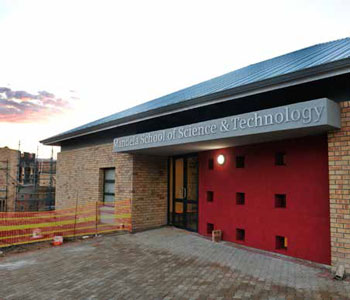 This was because the village did not have a high school. For those who wanted to pursue education beyond Grade 9, it meant travelling to neighbouring towns such as Mthatha and Idutywa.
This was because the village did not have a high school. For those who wanted to pursue education beyond Grade 9, it meant travelling to neighbouring towns such as Mthatha and Idutywa.
But the Mandela School of Science and Technology, which opened its doors in Mvezo earlier this year, is changing the lives of many of its pupils. It’s the first comprehensive science high school in the entire rural Transkei that offers subjects like engineering and information technology. Now, government believes more similar schools are needed in rural areas.
President Jacob Zuma, who unveiled a statue of Madiba’s grandfather, Prince Mandela, at the school recently, had nothing but praise for the school and its staff.
President Zuma said government was serious about ensuring that all children in disadvantaged communities were exposed to science and technology at school.
The idea for the school was born when Madiba said he wanted a high school built in his birthplace. In 2010, telecommunications giant Siemens pledged million of rands towards the school’s construction.
“Nelson Mandela was serious about education, it is something that was close to his heart and he wanted to see South Africa succeed,” President Zuma said.
The statue, which stands in front of the imposing building, depicts an image of Prince Mandela, son of King Ngubengcuka of the Thembu nation.
School principal Pat Toni said the school had brought about many changes to the community.
The school has four laboratories, a library, information technology department and an agricultural science department.
“We have very highly qualified teachers for science and mathematics. I think what the school has brought to this village is quality education - something unfortuthenately that children in rural areas are not used to,” says Toni.
Toni says the statue of Prince Mandela, unveiled by the president at the school, symbolises the active role that is being played by the community within the school.
“It also directs the school towards its roots. The school didn’t just appear; it has its roots embedded in the Mandela legacy.
“The community has embraced the school. We are receiving hundreds of applications and we cannot cope with the demand. Whenever we have a meeting, we have a full hall and the support is amazing.”
The school will have its first Grade 12 class in 2016 and Toni says several universities have committed to grant bursaries to all deserving pupils from the school.
There are also overseas universities that are lining up to take matriculants.
“For these reasons, our emphasis is on mathematics and technology because we know the expectation is very high and we are aware that these subjects will open many opportunities for our pupils,” Toni says.
One of those who is grateful for the school is Nothobile Mapeyi. Her granddaughter Zukiswa was forced to leave home to stay with her aunt in Mthatha after she passed Grade 9 in 2012. But now Zukiswa will be able to do her matric at the Mandela School of Science and Technology and live with the family in Mvezo.
“It’s something that really makes me happy. I was not happy when my child had to leave but we had no choice because I wanted her to continue with her studies. Now we have this good school at our doorstep. The future is looking bright for her,” says Mapeyi.
Free trade agreement a distant prospect
Free trade agreement a distant prospect sadminInternational relations
South Africa’s trade with Brazil, Russia, China and India may have mushroomed in recent years, but Minister of Trade and Industry Rob Davies says it’s still too early to talk about a free trade agreement among the grouping.
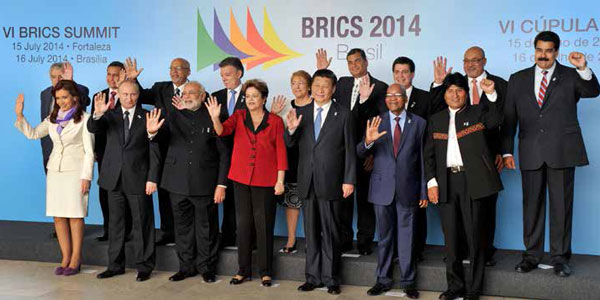 Free trade is trade between countries, free from governmental restrictions or duties.
Free trade is trade between countries, free from governmental restrictions or duties.
Intra-Brics (Brazil, Russia, India, China and South Africa) trade has increased steadily over the last three years. In South Africa trade data from the Department of Trade and Industry (dti) reveals that between 2010 and last year South Africa’s exports to its Brics partners increased by 76 per cent to R155, 3 billion, while imports from the grouping were up 95 per cent to R225, 5 billion over the same period.
South Africa’s exports to Brics countries last year accounted for 16,7 per cent of the country’s total exports, up from 13 per cent of all exports in 2010. In contrast South Africa’s imports from Brics as a percentage of total imports grew from 19 per cent to 22, 6 per cent over the same period.
With so much trade now flowing through Brics the case for a free trade agreement may seem a reasonable next step in bolstering trade relations among members of the bloc, but Minister Davies is cautious.
“Some people talk about it (a Brics free trade agreement) from time to time, but our (South Africa’s) view is that it is quite premature,” said Minister Davies from the 6th Brics Summit held in Fortaleza, Brazil, in July.
He said without strong support and the addition of non-trade measures, member countries would not realise the full benefits of a free trade agreement.
Brics trade ministers believe that for trade to flourish between emerging economies, these countries should buy more sophisticated goods from one another. Their concern is that there is too little value-added trade between the members.
For example South Africa has a significant canning and beverage industry, but last year just three per cent of prepared South African foodstuffs and beverages went to Brics countries.
Added to this, a report last year by the Industrial Development Corporation (IDC) revealed that South Africa’s exports to India and China are “highly concentrated” with them dominated by minerals commodities, mainly iron ore, concentrates and coal.
It’s not just South Africa. Brazil’s National Confederation of Industry points out that more than 70 per cent of Brazilian exports to its Brics partners consist of soya, iron ore and oil, whereas manufactured goods comprise 95 per cent of Brazil’s imports from these countries. Brics members are considering ways to counter this, having completed a joint trade study of recommendations for promoting valueadded exports among member countries.
Minister Davies said the study, which was handed to Brics trade ministers during the summit, details the different value-added activities in which each Brics member has a comparative advantage and also list a series of measures that need to be addressed to increase trade in valueadded goods and services between Brics members.
The trade ministers have instructed the group to continue working on its recommendations.
The summit also saw the signing of a memorandum of understanding on cooperation among Brics export credit and guarantees agencies. The agreement will allow two agencies to cooperate in providing support for a project in a third country which involves the supply of goods and services from Brics countries.
Team SA: Celebrating home-brewed champs
Team SA: Celebrating home-brewed champs sadminSport, arts and culture
Sport Minister Fikile Mbalula says Team SA’s outstanding performance at the 2014 Commonwealth Games in Glasgow is a clear indication that sport in South Africa is on the rise.
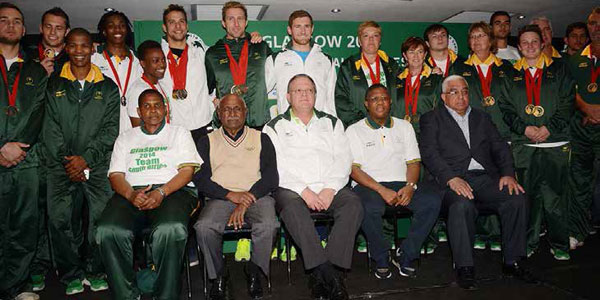 “This is [one of the most] outstanding performances by our athletes since the dawn of democracy in 1994 and we can proudly say that we’ve entered the era of hope that sport in South Africa is on the rise. We are looking forward [to] our athletes competing in the 2016 Olympics in Rio de Janeiro,” he said.
“This is [one of the most] outstanding performances by our athletes since the dawn of democracy in 1994 and we can proudly say that we’ve entered the era of hope that sport in South Africa is on the rise. We are looking forward [to] our athletes competing in the 2016 Olympics in Rio de Janeiro,” he said.
Minister Mbalula was speaking at an event celebrating South Africa’s medal winners at Nelson Mandela Square in Sandton recently.
Team SA clinched 40 medals in Glasgow. Thirteen gold, 10 silver and 17 bronze medals were paraded through the streets of Johannesburg in an open top bus.
Much to the thrill of the medal winners’ fans, who came out in their numbers, Minister Mbalula said: “You don’t put mediocrity in an open top bus. We put people of substance and winners, and these are winners - they deserve it. They made all of us proud and they are our good ambassadors.
“We are saying to our athletes and the generation to come: if you win, this great country will give you due recognition. Today, we are a winning team because of them, so we cannot have their celebration anywhere else but facing Nelson Mandela’s statue because Mandela represents progress, winning and humanity.
“Sport is about the fight of the human spirit. That is why we are here today.”
Minister Mbalula expressed confidence that Team SA’s winning spirit will reverberate across the national teams.
However, the celebrations took place without Team SA’s swimmers, who were all in Pietermaritzburg for the Final World Short Course Championship qualifiers.
Minister Mbalula presented the medal winners, the majority of whom were represented by their family members, with cheques.
The team finished seventh on the world medal standings and first on the Africa continent. Swimming produced 12 medals in total, including three gold, three silver and six bronze.
US-Africa summit was positive - Minister Davies
US-Africa summit was positive - Minister Davies sadminSouth Africa and Africa in general benefited immensely from the recent US-Africa Leaders’ Summit held in Washington, said Trade and Industry Minister Rob Davies.
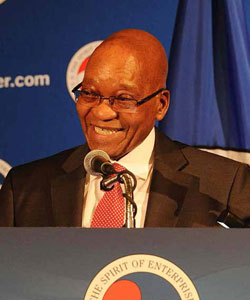 “By and large, there are a lot of positive things we gained from the summit… The message from all of us was that the African continent needs to industrialise and there were a lot of echoes in that regard,” he said.
“By and large, there are a lot of positive things we gained from the summit… The message from all of us was that the African continent needs to industrialise and there were a lot of echoes in that regard,” he said.
Minister Davies added that the major victory from the summit was the commitment by US President Barack Obama to support the renewal of the Africa Growth Opportunities Act (AGOA), and the various investments he announced to the tune of US$33 billion in Africa through the programme called Doing Business in Africa.
More than 40 Heads of State and Government, including President Jacob Zuma, attended the summit, which was convened by President Obama in August. The summit focused on peace and security as well as trade between Africa and the world’s economic giant.
On the renewal of AGOA, Minister Davies said the summit provided an indication that US believes a lengthy re-authorisation of AGOA was justified.
“They are looking at possibilities of improving AGOA. They said they are looking at the eligibility criteria… They are looking at countries that did not qualify… I think that was the message from our side that was pretty good news,” he said.
Congress is scheduled to vote on the renewal of AGOA, whose current term expires next year.
President Obama said he was confident that congress would back the renewal of the scheme.
South Africa is the only country that makes extensive use of the tariff trade preferences provided by the US through AGOA and other schemes.
Film industry
Meanwhile, Minister Davies says there are a lot of partnerships South Africa can build with Hollywood studios to grow the local film industry.
This follows his visit to Hollywood, Los Angeles, where he visited Disney and 20th Century Fox, among other big names in the film industry.
A study conducted by the National Film and Video Foundation found that in 2012, the film industry in South Africa employed around 25 000 compared to around 4 000, 10 years ago.
Minister Davies attributed the growth in the local film industry to government’s role in developing capacity within the industry through rebates and investment in film studios.
The rebates programme, which is operated by the Department of Trade and Industry, seeks to promote South African productions. It allows producers to get 20-25 per cent in rebates for locally produced films.
“It has led to a substantial increase in the number of films produced in SA,” Minister Davies said.
Dti to change tune of music industry
Dti to change tune of music industry sadminSport, arts and culture
The South African music industry is in for exciting times, as the Department of Trade and Industry (dti) prepares to help local talent to shine.
The dti has completed work on a strategy to develop the local music industry as part of its Industrial Policy Action Plan (IPAP).
“The music strategy has been completed with all consultations processes closed,” said dti Deputy Director- General (DDG) for consumer and corporate regulation, Zodwa Ntuli.
The strategy proposes improving access to finance by industry players, supporting manufacturing and access to technology, facilitating market access to domestic and international markets as well as skills development. According to DDG Ntuli, the findings of the Copyright Review Commission show that the distribution of royalties to artists goes abroad.
“When you look at how much in terms of royalties get to be paid, the statistics are showing that over 70 per cent is actually being paid to the outside companies,” said DDG Ntuli. This was because of the ownership structure, given that a number of recording companies in South Africa are outside companies.
According to DDG Ntuli, all these interventions will be coordinated by government and will include the Department of Arts and Culture as well as finance institutions of government.
“The export potential of this sector and the creative industry at large is huge with increasing demands in the US and Europe, but our markets continue to be dominated by imports,” she said.
She said that the creative industry contributes to the country’s Gross Domestic Product (GDP).
“In terms of the study that we conducted, we actually find that if you look at our GDP figures, the creative industry contributes about 4 per cent of our GDP, but what we are saying is that there is a potential for it go above that.
“If you look at countries like the US and countries in Europe, they are at about 11 per cent, both on the side of the contribution to GDP but as well as the creation of employment. This is also because they have put in place systems that have formalised the industry so it’s much more structured.
“If we as government focus on supporting this industry and putting the right mechanisms in place to incentivise growth in the industry, then we have a potential to even improve and increase the job creation that is there,” said DDG Ntuli.
Black Filmmakers Fund boosts local talent
Black Filmmakers Fund boosts local talent sadminAspiring young, black filmmakers in South Africa now have the chance see their productions come to life, thanks to a new fund set up for local emerging filmmakers.
 Established by the Industrial Development Corporation (IDC), which falls under the Department of Economic Development, and the National Film and Video Foundation (NFVF), the new Emerging Black Filmmakers Fund (EBFF) will offer black filmmakers financial support and assistance for their productions.
Established by the Industrial Development Corporation (IDC), which falls under the Department of Economic Development, and the National Film and Video Foundation (NFVF), the new Emerging Black Filmmakers Fund (EBFF) will offer black filmmakers financial support and assistance for their productions.
According to IDC’s head of Media and Motion Pictures Basil Ford, the new fund aims to strengthen the local film industry and ensure that filmmakers and producers create compelling films that showcase South African talent. “We have identified a growing need to support the production of South African films and documentaries, particularly by black filmmakers and producers,” said Ford.
According to Economic Development Minister Ebrahim Patel, the IDC has funded over 40 of the 94 South African Films which were screened at local cinemas between 2010 and 2013. Of this, said the Minister, 19 were produced and directed by black filmmakers. “The IDC is committed to assisting black film producers enter the movie market,” added Minister Patel.
Since its inception in 2003, over R293 million has been pumped into black produced films such as Mandela: Long Walk to Freedom, Zulu Love Letter, Hotel Rwanda, Fanie Fourie’s Lobola, Vrou Soek Boer, iNumber Number and more.
Mandela: Long Walk to Freedom has earned two Academy Award nominations and scooped a Golden Globe last year, and also placed third in the list of Top 10 films by the African- American Film Critics Association in the same year. iNumber Number, which premiered at the Toronto Film Festival, also won the Audience Choice Award at the Jozi Film Festival, with Zulu Love Letter scooping 10 international film awards.
NFVF chief executive Zama Nkosi said the partnership with the IDC, addresses one of Foundation’s key objectives of ensuring that the past imbalances in the film industry are addressed and more young black filmmakers are given the chance to showcase their films.
The fund will assist six qualifying and viable feature films per year with R5,1million in funding each. The aim is to increase funding to assist 10 feature films per year, said the IDC.
